Abstract
In a previous study we isolated melanin-producing (mel) mutants of Vibrio cholerae and demonstrated that production of melanin during growth on solid media was stimulated by L-tyrosine and L-cysteine. In the studies reported here we analyzed factors that affected melanin production in liquid media and determined the abilities of radioactively labeled amino acids to serve as precursors for the formation of melanin by V. cholerae. Radioactivity from L-cysteine and from L-tyrosine was preferentially incorporated into partially purified melanin, providing further evidence for production of phaeomelanin by V. cholerae. Cuprous ions stimulated production of melanin by V. cholerae in defined liquid medium, but melanin formation was inhibited by high concentrations of L-cysteine or thiouracil. The inhibition of melanin formation by sulfhydryl compounds is most likely due to their ability to bind copper ions that are essential for tyrosinase activity.
Full text
PDF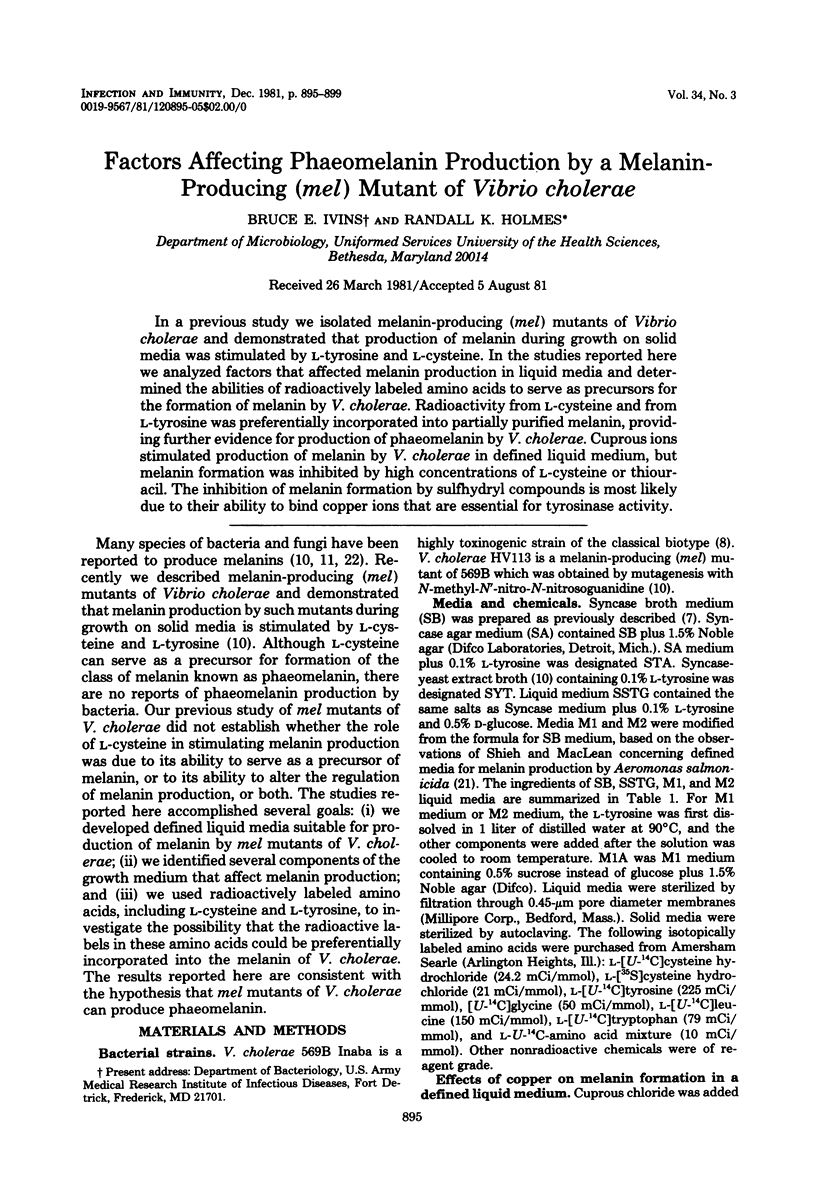
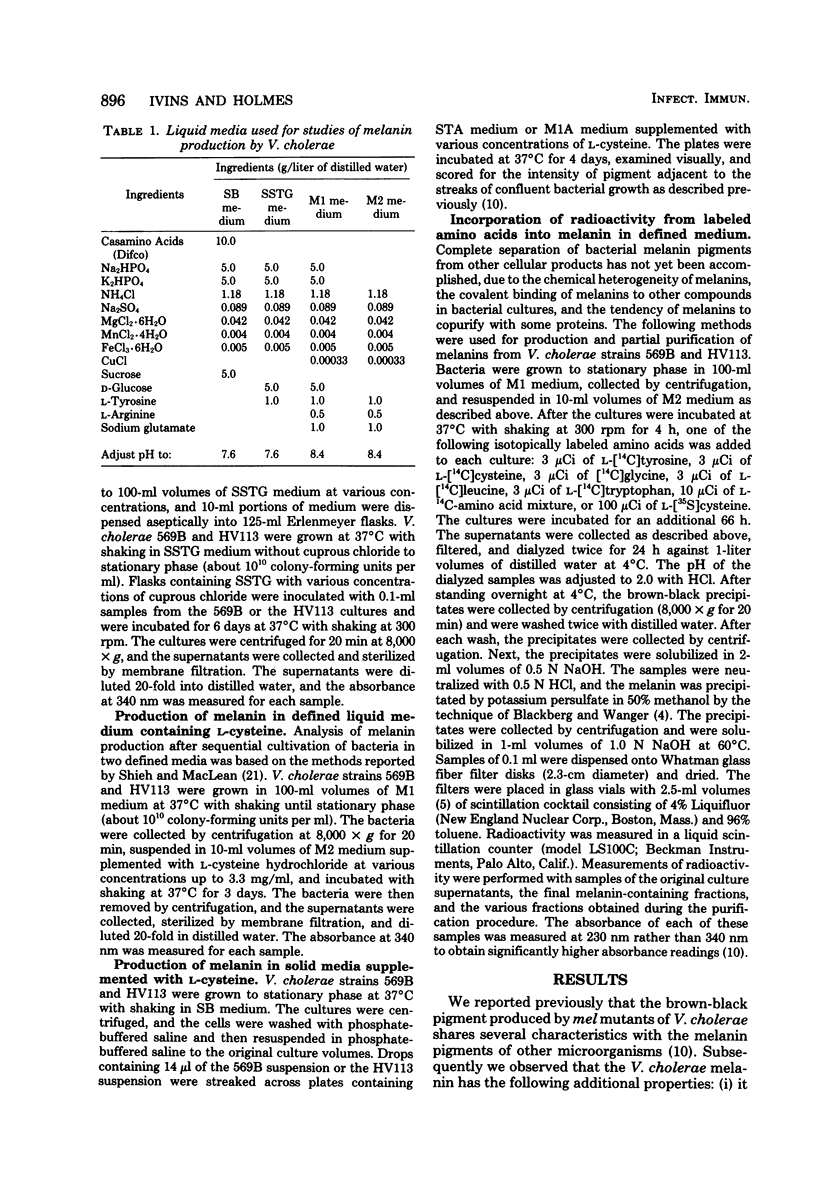
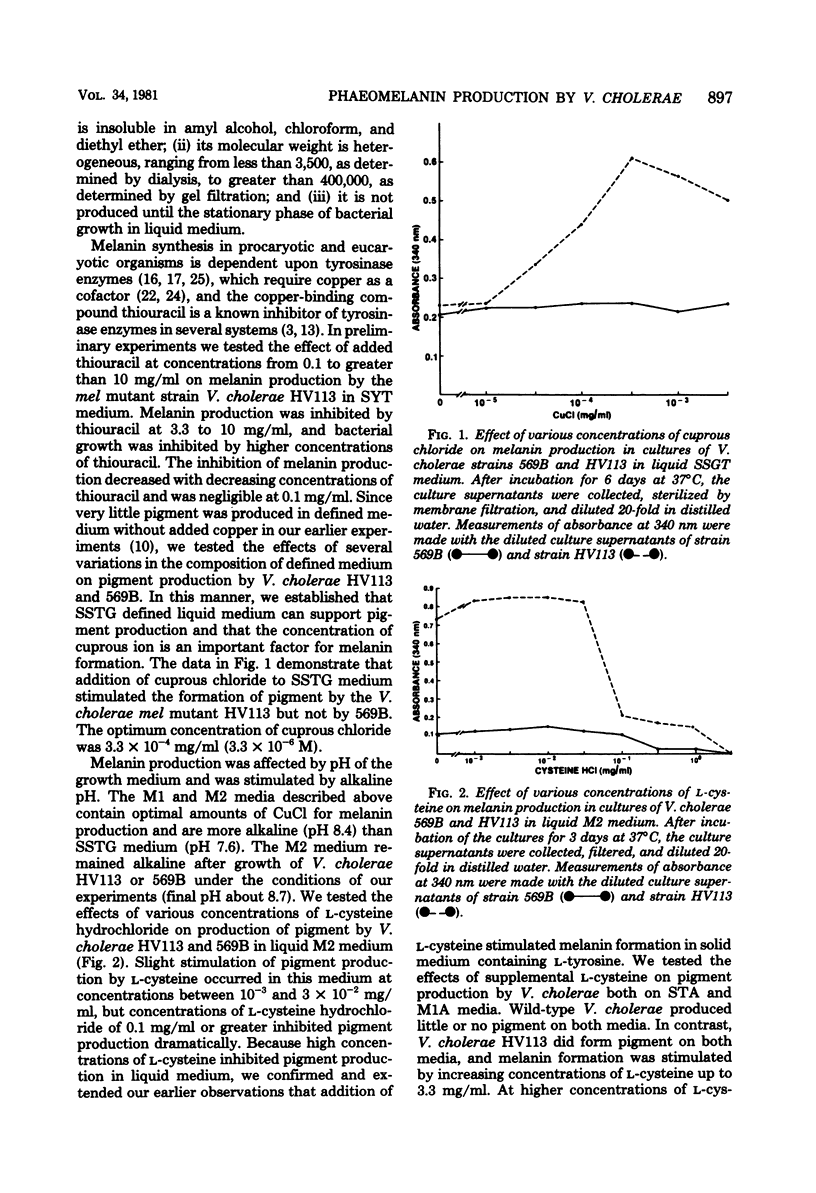
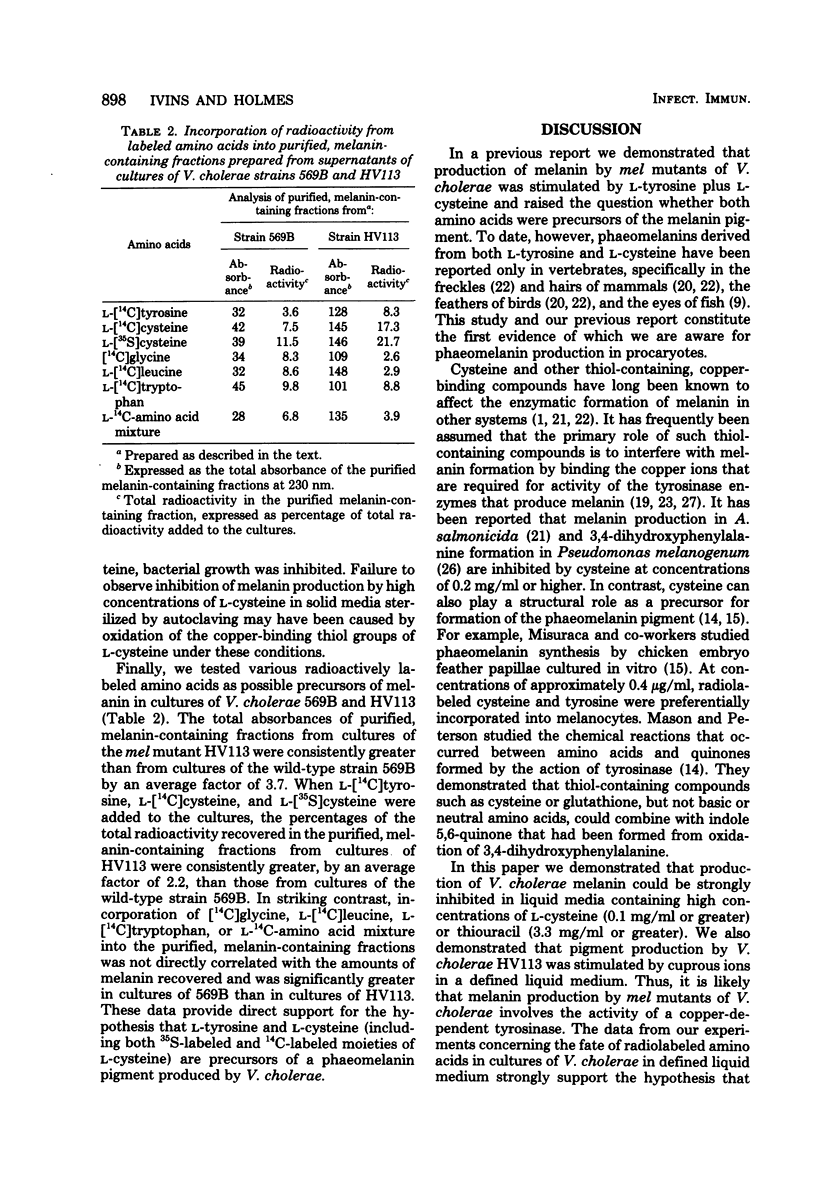
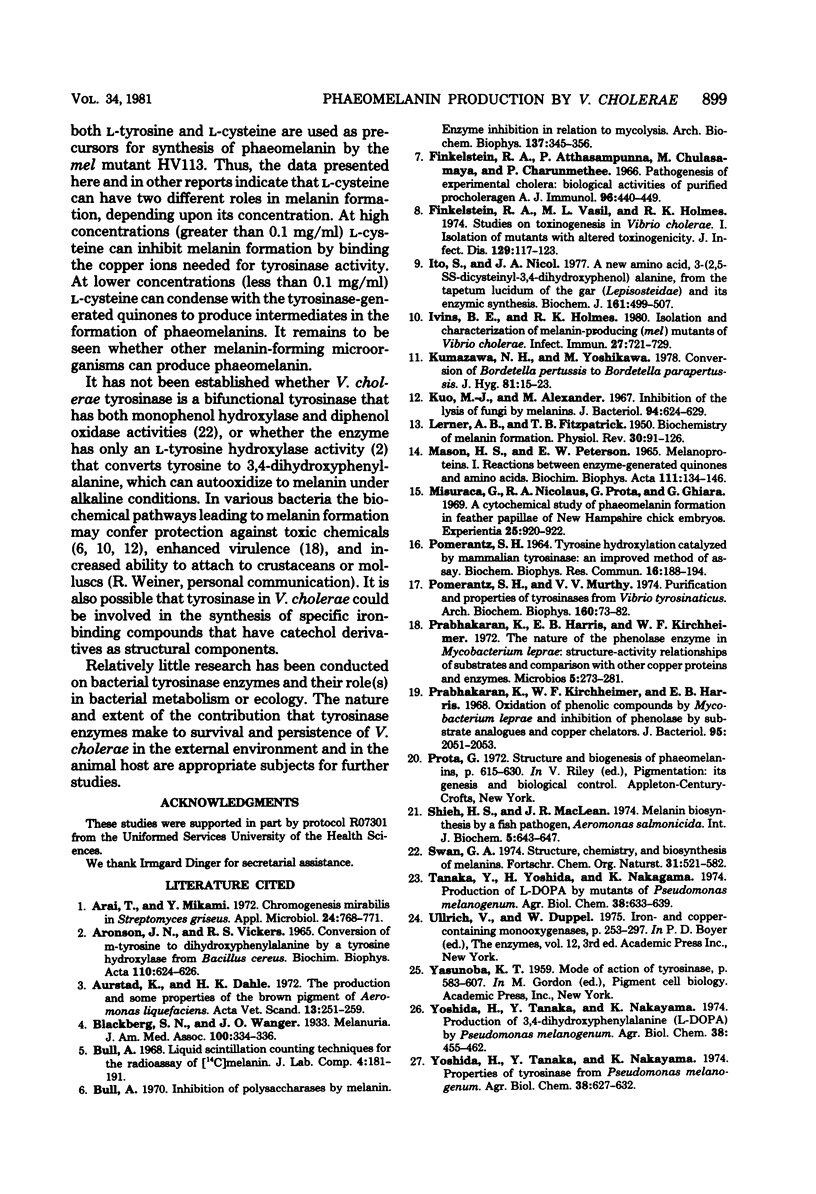
Selected References
These references are in PubMed. This may not be the complete list of references from this article.
- Arai T., Mikami Y. Chromogenesis mirabilis in Streptomyces griseus. Appl Microbiol. 1972 Nov;24(5):768–771. doi: 10.1128/am.24.5.768-771.1972. [DOI] [PMC free article] [PubMed] [Google Scholar]
- Aurstad K., Dahle H. K. The production and some properties of the brown pigment of Aeromonas liquefaciens. Acta Vet Scand. 1972;13(2):251–259. doi: 10.1186/BF03548579. [DOI] [PMC free article] [PubMed] [Google Scholar]
- Bull A. T. Inhibition of polysaccharases by melanin: enzyme inhibition in relation to mycolysis. Arch Biochem Biophys. 1970 Apr;137(2):345–356. doi: 10.1016/0003-9861(70)90448-0. [DOI] [PubMed] [Google Scholar]
- Finkelstein R. A., Atthasampunna P., Chulasamaya M., Charunmethee P. Pathogenesis of experimental cholera: biologic ativities of purified procholeragen A. J Immunol. 1966 Mar;96(3):440–449. [PubMed] [Google Scholar]
- Finkelstein R. A., Vasil M. L., Holmes R. K. Studies on toxinogenesis in Vibrio cholerae. I. Isolation of mutants with altered toxinogenicity. J Infect Dis. 1974 Feb;129(2):117–123. doi: 10.1093/infdis/129.2.117. [DOI] [PubMed] [Google Scholar]
- Ito S., Nicol J. A. A new amino acid, 3-(2,5-SS-dicysteinyl-3,4-dihydroxyphenyl)alanine, from the tapetum lucidum of the gar (Lepisosteidae) and its enzymic synthesis. Biochem J. 1977 Mar 1;161(3):499–507. doi: 10.1042/bj1610499. [DOI] [PMC free article] [PubMed] [Google Scholar]
- Ivins B. E., Holmes R. K. Isolation and characterization of melanin-producing (mel) mutants of Vibrio cholerae. Infect Immun. 1980 Mar;27(3):721–729. doi: 10.1128/iai.27.3.721-729.1980. [DOI] [PMC free article] [PubMed] [Google Scholar]
- Kumazawa N. H., Yoshikawa M. Conversion of Bordetella pertussis to Bordetella parapertussis. J Hyg (Lond) 1978 Aug;81(1):15–23. doi: 10.1017/s0022172400053729. [DOI] [PMC free article] [PubMed] [Google Scholar]
- Kuo M. J., Alexander M. Inhibition of the lysis of fungi by melanins. J Bacteriol. 1967 Sep;94(3):624–629. doi: 10.1128/jb.94.3.624-629.1967. [DOI] [PMC free article] [PubMed] [Google Scholar]
- LERNER A. B., FITZPATRICK T. B. Biochemistry of melanin formation. Physiol Rev. 1950 Jan;30(1):91–126. doi: 10.1152/physrev.1950.30.1.91. [DOI] [PubMed] [Google Scholar]
- Mason H. S., Peterson E. W. Melanoproteins. I. Reactions between enzyme-generated quinones and amino acids. Biochim Biophys Acta. 1965 Nov 15;111(1):134–146. doi: 10.1016/0304-4165(65)90479-4. [DOI] [PubMed] [Google Scholar]
- Misuraca G., Nicolaus R. A., Prota G., Ghiara G. A cytochemical study of phaeomelanin formation in feather papillae of New Hampshire chick embryos. Experientia. 1969 Sep 15;25(9):920–922. doi: 10.1007/BF01898063. [DOI] [PubMed] [Google Scholar]
- Pomerantz S. H., Murthy V. V. Purification and properties of tyrosinases from Vibrio tyrosinaticus. Arch Biochem Biophys. 1974 Jan;160(1):73–82. doi: 10.1016/s0003-9861(74)80010-x. [DOI] [PubMed] [Google Scholar]
- Pomerantz S. H. Tyrosine hydroxylation catalyzed by mammalian tyrosinase: an improved method of assay. Biochem Biophys Res Commun. 1964 Jun 1;16(2):188–194. doi: 10.1016/0006-291x(64)90359-6. [DOI] [PubMed] [Google Scholar]
- Prabhakaran K., Harris E. B., Kirchheimer W. F. The nature of the phenolase enzyme in Mycobacterium leprae: structure-activity relationships of substrates and comparison with other copper proteins and enzymes. Microbios. 1972;5(20):273–281. [PubMed] [Google Scholar]
- Prabhakaran K., Kirchheimer W. F., Harris E. B. Oxidation of phenolic compounds by Mycobacterium leprae and inhibition of phenolase by substrate analogues and copper chelators. J Bacteriol. 1968 Jun;95(6):2051–2053. doi: 10.1128/jb.95.6.2051-2053.1968. [DOI] [PMC free article] [PubMed] [Google Scholar]
- Swan G. A. Structure, chemistry, and biosynthesis of the melanins. Fortschr Chem Org Naturst. 1974;31(0):521–582. doi: 10.1007/978-3-7091-7094-6_9. [DOI] [PubMed] [Google Scholar]


